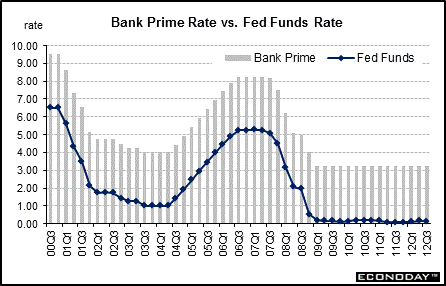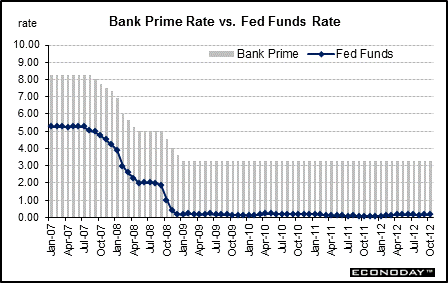 |

In the 1980s, the spread between the federal funds rate and the bank’s prime rate was 187 basis points, less than the 281 basis point spread averaged in the 1990s. While it appears that banks got greedy in the 1990s, the reality is that the “bank prime rate” has a different meaning today. In the 1980s, the prime rate was considered the lowest rate reserved for banks’ best customers. In the mid to late 1980s, the best customers were getting charged lower rates than the prime rate. Banks changed the name of the prime rate to “corporate base rate.” These days, many consumer and small business loans are tied to this rate. As a result, the spread is fixed at 300 basis points. When the Fed for the first time established a range (instead of a single percentage) for the fed funds target rate at its December 15-16, 2008 FOMC meeting, the prime rate was set at 300 basis points above the top of the fed’s target range (of zero to 0.25 percent at that time). Over the 2000 through 2011 period, this spread averaged 304 basis points.

The bank prime rate is an administered rate, not a market rate, and is tied directly to the federal funds target rate. Whenever the Federal Reserve Board announces a change in the fed funds target rate, banks will alter their prime rate within 24 hours by an equal amount. If the prime rate were tied to market rates, it would fluctuate in tandem with yields on Treasury securities.
Interest rates on equity loans and credit card debt are typically tied to the prime rate. The Fed raised the federal funds rate target 17 times from June 30, 2004 through June 29, 2006, before the latest easing cycle began in September 2007. The Fed has cut the fed funds target rate from a recent peak of 5.25 percent in mid-2007 to the target range of zero to 0.25 percent set December 16, 2008 where it has remained through the October 24, 2012 FOMC meeting announcement. Although some credit card companies continue to offer reduced interest rates on balance transfers or new purchases for limited periods, overall, credit card companies have tightened up on lending. Also, since the subprime crisis, lenders frequently have lowered existing credit ceilings not just for credit cards but also for home equity lines of credit (HELOC). Lenders also have been less willing to establish new HELOC accounts. The bank prime rate is a key lending rate that determines home equity loan rates as well as credit card rates. In October the average bank prime rate was unchanged at 3.25 percent while the effective fed funds rate edged up 1 basis point 0.16 percent (monthly average).

Values reflect monthly averages rather than end of period.


About the Bond Market • Bond Market Charts • Treasury Market Charts • Treasury Auctions
|
 |

